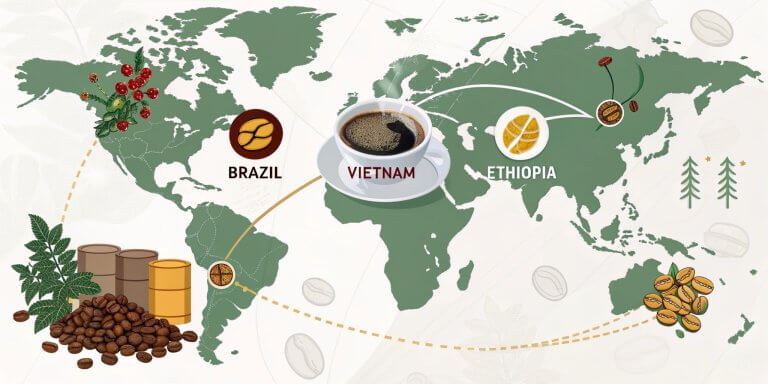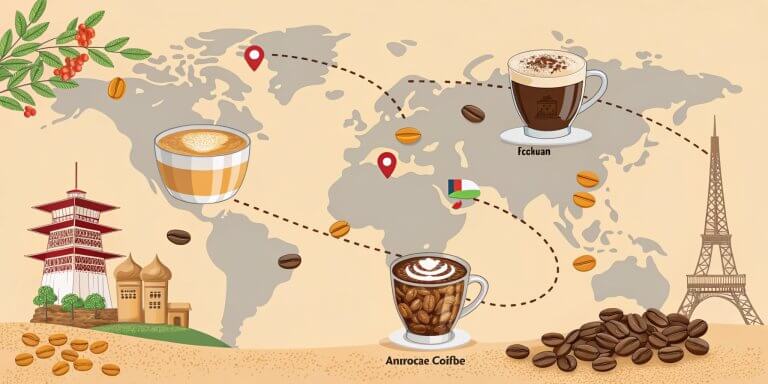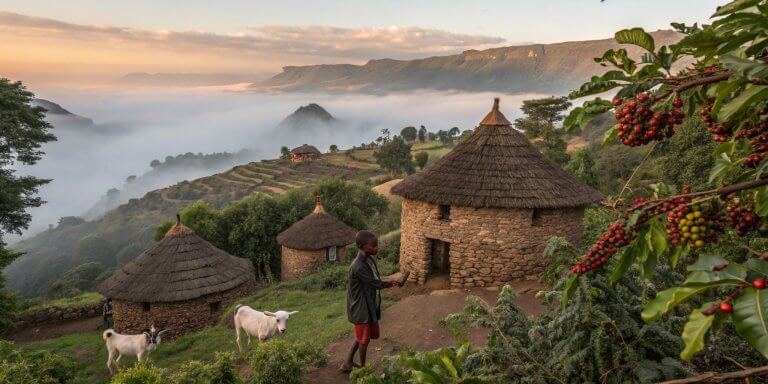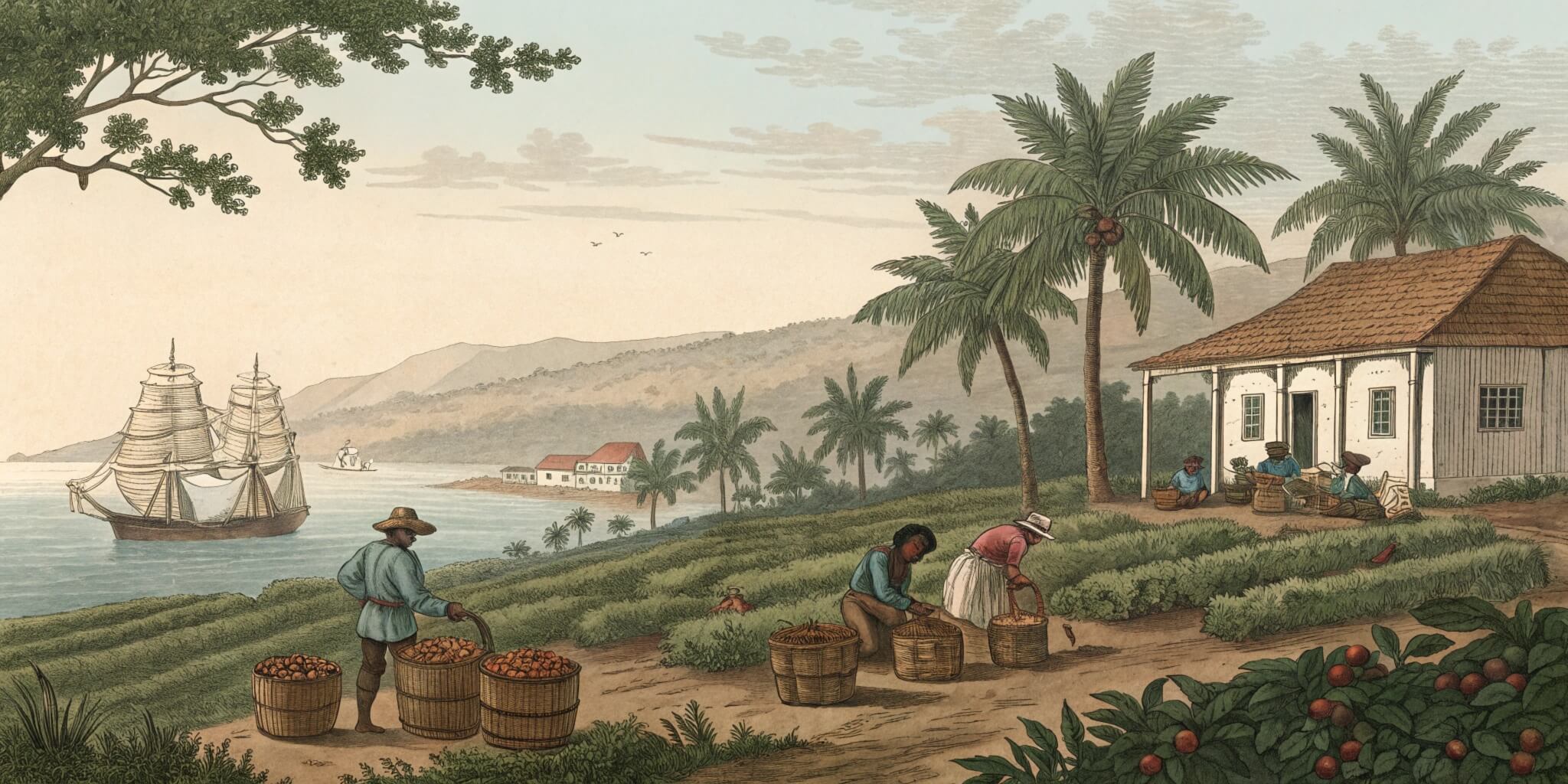
Many of us start our day with a cup of coffee, savoring its rich flavor and the energy boost it provides. But behind that simple pleasure lies a long, dark history tied to colonialism, exploitation, and the suffering of millions. The journey of coffee from the farms to your cup is deeply intertwined with centuries of forced labor and the harsh realities between Coffee and Colonialism. Let’s take a closer look at how coffee became a global commodity at such a high human cost.
The Early Days: From Ethiopia to the Arabian Peninsula
Coffee’s journey begins in Ethiopia, where legend has it that a goat herder named Kaldi discovered the energizing properties of coffee beans after observing his goats acting energetically after eating them. From Ethiopia, coffee spread to Yemen in the 15th century, where it was cultivated and exported to other regions. The port of Mocha in Yemen became a significant center of the coffee trade, and this is where coffee first started its path toward global prominence.
The Arabian Peninsula, fiercely protective of its coffee, tried to maintain control over its cultivation by ensuring that only infertile seeds were exported. However, this control didn’t last long, and soon, European powers got their hands on coffee, beginning the next chapter of coffee’s history—one marked by colonial exploitation.
Coffee and the Beginnings of Colonial Expansion
The European thirst for coffee exploded in the 17th century. The Dutch were the first to break Arabia’s monopoly, smuggling coffee plants to their colonies in Java, present-day Indonesia. The Dutch established vast coffee plantations on stolen land, using forced local labor to cultivate and harvest the beans. Life on these plantations was brutal, and many workers died due to the inhumane conditions.
As the Dutch profited, other European powers followed suit. France, Britain, Spain, and Portugal established coffee plantations across the Caribbean and Central and South America. These regions offered fertile land, and European colonists were eager to exploit it for coffee cultivation, often at the expense of local populations.
The Atlantic Slave Trade and Coffee Plantations
The 18th century they marked a significant turning point in coffee production with the rise of the Atlantic slave trade. To meet the increasing demand for coffee, European colonizers turned to Africa, enslaving millions of people to work on coffee plantations in the Caribbean and the Americas. Haiti, then a French colony, became one of the world’s largest coffee producers; by 1788, half of the world’s coffee came from slave labor on Haitian plantations.
Conditions on these plantations were horrendous. In Haiti, enslaved Africans were subjected to brutal treatment, malnutrition, and overwork. The goal was to produce coffee as cheaply as possible, with little regard for human life. In Brazil, which would later become the world’s largest coffee producer, over two million enslaved Africans were forced to work on coffee plantations. Life expectancy on these plantations was shockingly low, with many workers surviving only seven years due to the extreme conditions.
The Brutal Reality of Coffee Labor in Latin America
In Central and South America, where coffee became a key export, Indigenous populations were also exploited. The Spanish colonizers, for instance, forcibly removed Indigenous people from their land and made them work on coffee plantations. This form of labor was often described as “semi-slavery,” where Indigenous workers were coerced into cultivating coffee on land that once belonged to them.
The impact of this exploitation was long-lasting. Many Indigenous communities lost their ancestral lands, and the coffee industry became a tool of oppression, deepening inequality in the region.
Coffeehouses and the Colonial Economy
While coffee plantations in the colonies were fueled by slave labor, coffeehouses in Europe flourished as social hubs for the wealthy. Coffeehouses were places where merchants, traders, and politicians gathered to discuss business and strike deals—many of which involved the coffee trade. These coffeehouses became symbols of prosperity and culture in Europe, while the people who produced the coffee suffered in the colonies.
This contrast between the luxurious European coffeehouses and the brutal conditions on coffee plantations highlights the stark inequalities at the heart of the coffee trade. While Europeans enjoyed the benefits of coffee, millions of people in the colonies were forced to work in horrific conditions to supply it.
The Legacy of Exploitation in Coffee Production
Even after slavery was abolished in the 19th century, the exploitation of labor continued in the coffee industry. Many formerly enslaved people were forced into systems of debt peonage, where they were trapped in a cycle of low wages and crushing debt. In Brazil, for example, laborers were often paid so little that they could not escape the plantations they worked on, and they remained indebted to landowners for life.
Today, colonialism’s legacy is still evident in the coffee industry. Many coffee-producing countries in Africa, Latin America, and Asia struggle with poverty, inequality, and labor exploitation. Small-scale coffee farmers often live in poverty, receiving only a fraction of the profits generated by the global coffee trade.
The Modern Coffee Trade: Fair Trade and Ethical Sourcing
The fair trade movement emerged in the late 20th century in response to the long history of exploitation in the coffee industry. Fairtrade aims to ensure that coffee farmers receive fair wages, work in safe conditions, and have access to education and healthcare. However, while fair trade has made significant strides, critics argue that it still needs to address the systemic issues in the coffee industry fully.
Many coffee workers today still face poor working conditions, long hours, and low wages. In Brazil, for instance, coffee workers earn as little as 2% of the retail price of coffee.
Fairtrade coffee accounts for only a tiny portion of the global market, and many workers continue to be exploited under similar conditions to those during the colonial era.
Environmental and Social Justice Concerns
Coffee production also has significant environmental impacts. Expansion of coffee plantations often leads to deforestation, which harms biodiversity and contributes to climate change. In addition, coffee farming is a water-intensive process, and unsustainable farming practices can lead to soil degradation and water pollution.
Environmental and social justice issues must be addressed for coffee production to become sustainable. This includes ensuring that farmers are paid fairly, that labor rights are respected, and that farming practices protect the environment.
Conclusion
The history of coffee is deeply tied to colonialism, slavery, and exploitation. From its early cultivation in the Arabian Peninsula to the vast plantations of the Americas, coffee’s journey has been marked by the suffering of millions. As we enjoy our morning cup, it’s important to remember the people who have worked—and continue to work—under harsh conditions to produce this beloved beverage.
While steps like fair trade have been taken to improve the industry, much more must be done to address the current systemic inequalities. By supporting ethical and sustainable coffee brands, we can help ensure that coffee’s future is not as bitter as its past.


